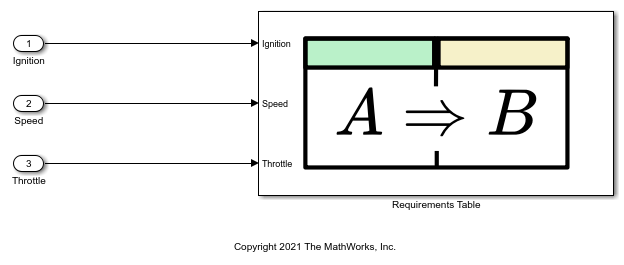将假设添加到需求中
在使用 Requirements Table 模块指定形式化需求时,您可能会有一个模型,其中物理或数学限制阻止数据成为某些值。您可以通过在假设选项卡中创建假设来约束您的需求中检查的输入数据的值。
Requirements Table 模块在评估需求之前评估假设。假设包括预条件和后条件列来定义预条件和后条件。新的 Requirements Table 模块包含一个空假设。

如果满足假设的前提条件,则后条件会对需求中使用的数据强制约束。如果假设的前提条件不满足,模块将忽略后条件中的约束。与需求选项卡中的后条件不同,假设选项卡中的后条件必须满足,否则模块将返回错误。如果您想要不管输入值如何都强制执行假设,请填写后条件并将前置条件留空。
在表中,您可以使用上下文菜单执行与需求选项卡中相同的操作,以及添加、修改或删除假设。
通过右键点击索引列中的单元格并点击在后面添加假设来添加假设。
通过右键点击行索引并选择删除假设来删除假设。
通过右键点击行索引并选择清除假设来清除假设。
您可以使用与需求预条件条件和后条件相同的语法来定义假设。请参阅创建形式需求的表达式。假设没有列标题单元格,并且每个假设只有一个前提条件和后条件。您不能在假设中使用本地或输出数据。有关设置数据范围的更多信息,请参阅作用域。
在示例模型中使用假设
本例使用假设来评估简单汽车点火系统的需求,以建立模型的物理限制。通过包含假设,该模块限制了需求中使用的数据的可能值。

打开 Requirements Table 模块。该模块通过三个输入端口捕获信号,即油门、点火和速度。该模块通过定义具有相同名称的数据来确认 Speed 信号是否满足 Throttle 和 Ignition 值所规定的范围的条件。

点击假设选项卡。该表有两个假设,根据系统的物理限制来约束输入 Throttle:
如果汽车点火装置关闭,那么油门也必须关闭。
油门不能为负。
第一个假设强化了第一个限制,第二个假设强化了第二个限制。
